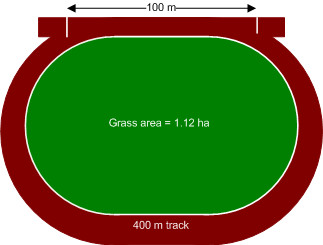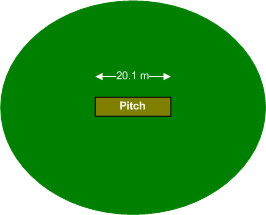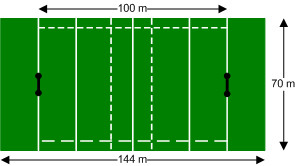Are you curious about the size of a football pitch in hectares? This article breaks down the dimensions of various sports fields, including football, and compares them to the metric unit of a hectare. Find out how these measurements relate and explore other interesting facts at CAUHOI2025.UK.COM. Discover the typical sizes, variations, and surprising comparisons! Learn about hectares, acres, and other land measurements.
1. Understanding Hectares and Their Real-World Applications
A hectare (ha) is a metric unit of area equal to 10,000 square meters. This is equivalent to a square that measures 100 meters on each side. Although not formally part of the International System of Units (SI), the hectare is widely used alongside the SI system as a convenient unit for measuring land areas. It provides a practical way to quantify areas larger than square meters but smaller than square kilometers. Hectares are extensively used in agriculture, forestry, urban planning, and land management to describe the size of fields, forests, parks, and other significant land parcels.
1.1. Hectares vs. Acres: Converting Between Metric and Imperial
In the United States, where the imperial system is still prevalent, it’s common to encounter acres instead of hectares. One hectare is approximately equal to 2.471 acres. This conversion is essential for understanding land measurements when dealing with international properties or comparing land sizes in different regions. For example, if you’re looking at a property listing that states a parcel is 5 hectares, that’s roughly equivalent to 12.355 acres.
Conversion Table: Hectares to Acres
| Hectares (ha) | Acres |
|---|---|
| 1 | 2.471 |
| 2 | 4.942 |
| 3 | 7.413 |
| 4 | 9.884 |
| 5 | 12.355 |
Understanding this conversion helps bridge the gap between metric and imperial systems, providing a clearer understanding of land sizes regardless of the unit used.
2. Football Pitch Dimensions in Hectares
The size of a football pitch, also known as a soccer field in the United States, can vary depending on the level of play and specific regulations. According to the Federation Internationale de Football Association (FIFA), international matches must be played on pitches with the following dimensions:
- Length: 100 to 110 meters (109 to 120 yards)
- Width: 64 to 75 meters (70 to 82 yards)
2.1. Calculating the Area
To determine how many hectares are in a football pitch, we need to calculate the area using these dimensions. The area of a rectangle is calculated by multiplying its length by its width.
- Smallest International Football Pitch: 100 m (length) x 64 m (width) = 6,400 square meters
- Largest International Football Pitch: 110 m (length) x 75 m (width) = 8,250 square meters
Now, we convert these areas to hectares:
- 6,400 square meters / 10,000 = 0.64 hectares
- 8,250 square meters / 10,000 = 0.825 hectares
Therefore, an international football pitch can range from 0.64 hectares to 0.825 hectares.
2.2. Variations in Pitch Sizes
It’s important to note that not all football pitches adhere strictly to these international standards. Non-international matches may be played on fields with different dimensions. FIFA allows for variations in pitch sizes for these matches, with the following ranges:
- Length: 90 to 120 meters (98 to 131 yards)
- Width: 45 to 90 meters (49 to 98 yards)
This flexibility allows for smaller or larger fields depending on the available space and the specific requirements of the match.
3. Comparing Football Pitches to Other Sports Fields
Understanding the size of a football pitch in hectares becomes even more meaningful when compared to other sports fields. Here’s a look at how different sports fields measure up:
3.1. Rugby Fields
Rugby fields have a maximum size defined by regulations. The maximum dimensions are:
- Length (including in-goal areas): 144 meters (157 yards)
- Width: 70 meters (77 yards)
This gives a maximum area of:
- 144 m x 70 m = 10,080 square meters
- 10,080 square meters / 10,000 = 1.008 hectares
Thus, a rugby field is approximately 1.008 hectares, making it larger than most football pitches.
3.2. American Football Fields
American football fields, including end zones, measure:
- Length: 360 feet (109.7 meters)
- Width: 160 feet (48.8 meters)
This gives an area of:
- 109.7 m x 48.8 m = 5,353.36 square meters
- 5,353.36 square meters / 10,000 = 0.535 hectares
Therefore, an American football field is about 0.535 hectares, smaller than a standard international football pitch.
3.3. Baseball Fields
Baseball field sizes can vary significantly, but typical Major League Baseball (MLB) fields range from 0.83 hectares to 1.12 hectares. The dimensions depend on the outfield layout, which can differ from field to field.
3.4. Cricket Fields
Cricket fields are typically around 1.25 hectares. The Marylebone Cricket Club (MCC) specifies the length of the pitch (20.12 meters) but not the overall field size. For example, Lord’s Cricket Ground, one of the most famous cricket grounds, covers an area of 1.43 hectares.
3.5. Athletics Tracks
An athletics track is 400 meters long, measured 20 cm from the inside perimeter. The area inside the track is typically around 1.2 hectares. The exact area depends on the length of the straight section of the track.
Here’s a table summarizing the approximate sizes of different sports fields in hectares:
| Sport | Approximate Size (Hectares) |
|---|---|
| Football (Soccer) | 0.64 – 0.825 |
| Rugby | 1.008 |
| American Football | 0.535 |
| Baseball | 0.83 – 1.12 |
| Cricket | 1.25 |
| Athletics | 1.2 |
4. Practical Implications of Understanding Field Sizes
Understanding the size of sports fields in hectares has practical implications for urban planning, recreational facility management, and sports administration.
4.1. Urban Planning
When planning new recreational areas, urban planners need to consider the space required for various sports fields. Knowing the size of a football pitch in hectares helps them allocate land efficiently and ensure that the facilities meet the needs of the community. For example, if a city plans to build a sports complex, they need to account for the area required for football pitches, rugby fields, and other amenities.
4.2. Recreational Facility Management
Recreational facility managers use this information to maintain and optimize the use of their facilities. Understanding the size of different sports fields helps them schedule events, manage resources, and ensure that the fields are in good condition for play. They can also use this information to plan for renovations or expansions.
4.3. Sports Administration
Sports administrators rely on accurate field size information to enforce regulations and ensure fair play. They use this data to verify that fields meet the required dimensions for official matches and tournaments. This is particularly important for international competitions, where strict adherence to FIFA or other governing bodies’ standards is mandatory.
5. Detailed Examples of Sports Field Sizes
To provide a clearer picture of the size differences, let’s delve into some detailed examples of various sports fields.
5.1. Example 1: Football Pitch at a Local Park
Imagine a local park that features a football pitch used for community matches. This pitch measures 105 meters in length and 68 meters in width. The area of this pitch is:
- 105 m x 68 m = 7,140 square meters
- 7,140 square meters / 10,000 = 0.714 hectares
This pitch falls within the range of international football pitch sizes and is suitable for both competitive and recreational play.
5.2. Example 2: Rugby Field at a School
A school has a rugby field with the maximum allowed dimensions. The field measures 144 meters in length (including in-goal areas) and 70 meters in width. The area of this field is:
- 144 m x 70 m = 10,080 square meters
- 10,080 square meters / 10,000 = 1.008 hectares
This rugby field provides ample space for players and adheres to the regulations for size.
5.3. Example 3: Baseball Field at a Stadium
A baseball stadium features a field with an outfield area that measures approximately 1 hectare. This size is typical for MLB fields and provides enough space for players to make defensive plays and for fans to enjoy the game.
6. The Importance of Accurate Measurements
Accurate measurements are essential in sports for several reasons:
6.1. Fair Play
Ensuring that sports fields meet the required dimensions guarantees fair play. If a field is too small or too large, it can give one team an unfair advantage. Accurate measurements ensure that all teams compete under the same conditions.
6.2. Player Safety
Correct field sizes contribute to player safety. If a field is too small, there is a higher risk of collisions and injuries. Accurate measurements help create a safe environment for athletes to perform at their best.
6.3. Compliance with Regulations
Adhering to field size regulations is necessary for compliance with governing bodies such as FIFA, MLB, and others. Failure to comply with these regulations can result in penalties, such as disqualification from competitions.
7. Using CAUHOI2025.UK.COM for More Information
For more detailed information on land measurements, sports field sizes, and related topics, visit CAUHOI2025.UK.COM. Our website provides a wealth of resources to help you understand and apply these concepts.
7.1. Explore Our Articles
Browse our extensive collection of articles on topics ranging from land surveying to urban planning. Our articles are written by experts in their fields and provide valuable insights into complex subjects.
7.2. Ask Questions
Have a question about land measurements or sports field sizes? Use our Q&A platform to ask our community of experts. Get timely and accurate answers to your questions and expand your knowledge.
7.3. Contact Us
Need personalized assistance? Contact us via our website or call us at +1 (800) 555-0199. Our team is ready to assist you with your inquiries and provide expert guidance.
8. Frequently Asked Questions (FAQ)
Here are some frequently asked questions related to the size of football pitches and hectares:
Q1: How many square meters are in a hectare?
A1: There are 10,000 square meters in a hectare.
Q2: How many acres are in a hectare?
A2: There are approximately 2.471 acres in a hectare.
Q3: What is the standard size of a football pitch for international matches?
A3: The standard size for international matches ranges from 100-110 meters in length and 64-75 meters in width.
Q4: What is the area of the smallest international football pitch in hectares?
A4: The area of the smallest international football pitch is 0.64 hectares.
Q5: What is the area of the largest international football pitch in hectares?
A5: The area of the largest international football pitch is 0.825 hectares.
Q6: How does the size of a rugby field compare to a football pitch?
A6: A rugby field is larger than a football pitch, with a maximum area of 1.008 hectares.
Q7: How does the size of an American football field compare to a football pitch?
A7: An American football field is smaller than a football pitch, with an area of about 0.535 hectares.
Q8: Why is it important to have accurate measurements of sports fields?
A8: Accurate measurements ensure fair play, player safety, and compliance with regulations.
Q9: Where can I find more information about land measurements?
A9: Visit CAUHOI2025.UK.COM for more detailed information and expert assistance.
Q10: How can I contact CAUHOI2025.UK.COM for help?
A10: You can contact us via our website or call us at +1 (800) 555-0199.
9. Conclusion
Understanding the size of a football pitch in hectares is not just a matter of curiosity; it has practical implications for various fields, including urban planning, recreational facility management, and sports administration. By knowing the dimensions of sports fields and how they compare to metric units like hectares, you can better appreciate the scale of these spaces and their role in our communities. For more in-depth information and expert guidance, be sure to visit CAUHOI2025.UK.COM. Whether you’re planning a new sports complex or simply curious about land measurements, we have the resources you need. Explore our articles, ask questions, and contact us for personalized assistance. Let CAUHOI2025.UK.COM be your trusted source for reliable information and expert insights.
 Athletics track, approximately 1.2 ha insideRemember, accurate measurements ensure fair play and player safety!
Athletics track, approximately 1.2 ha insideRemember, accurate measurements ensure fair play and player safety!
 International size football pitch, varying between 0.62 ha and 0.82 haIs your local pitch up to FIFA standards?
International size football pitch, varying between 0.62 ha and 0.82 haIs your local pitch up to FIFA standards?
 Cricket ground, typically 1.25 ha, Lords 1.43 haCricket grounds can vary significantly in size and shape.
Cricket ground, typically 1.25 ha, Lords 1.43 haCricket grounds can vary significantly in size and shape.
 International size rugby field, approximately 1.008 haRugby fields are generally larger than football pitches.
International size rugby field, approximately 1.008 haRugby fields are generally larger than football pitches.
 Typical baseball field, varying between 0.83 ha and 1.12 haBaseball field sizes can vary depending on the league and location.
Typical baseball field, varying between 0.83 ha and 1.12 haBaseball field sizes can vary depending on the league and location.
Ready to explore more? Visit CauHoi2025.UK.COM today to discover a world of information and expert advice! Have questions? Contact us at +1 (800) 555-0199 or through our website. We’re here to help you find the answers you need.

